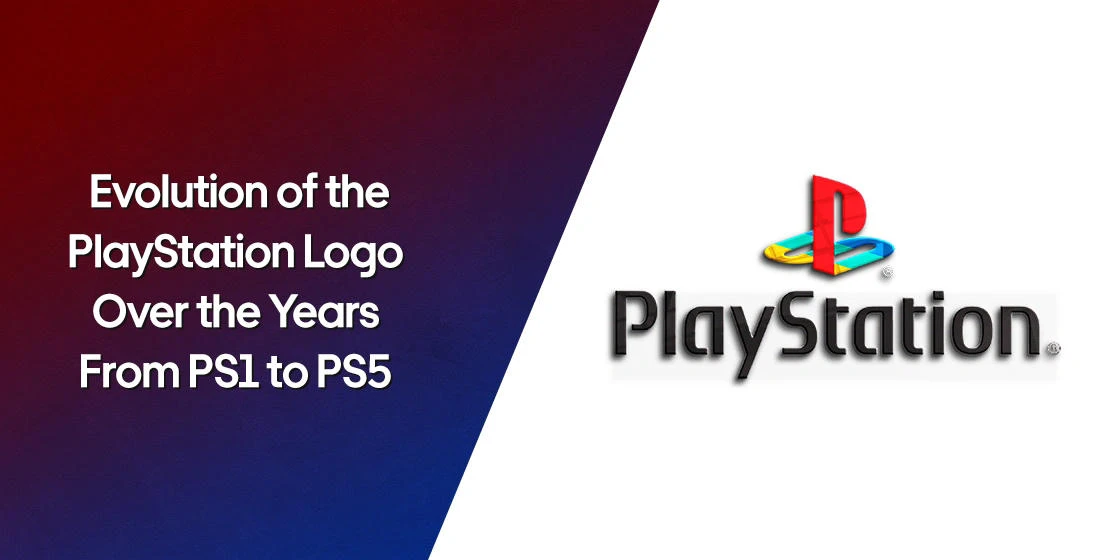
Table of Content
Discover How the PlayStation Logo Has Evolved Across the Various Generations
The PlayStation brand, since its inception in the mid-1990s, has become synonymous with high quality video gaming, shaping the video game console industry over the decades. And a major key to this massive success is not only the innovative hardware and the massive game library but also the instantly recognizable PlayStation logo.
The PlayStation brand’s logo, featuring the stylized “PS” initials, has undergone a subtle yet significant evolution over the years, reflecting the brand’s growth, technological advancements, and shifting design sensibilities. From the bold, colorful emblem of the original PlayStation to the monochrome, minimalist mark of the PlayStation today, each iteration tells a story of the console’s journey and its impact on the gaming landscape.
Understanding the evolution of the PlayStation logo requires a look back at the brand’s origins with the keen gaze of an expert logo design agency. In this article, we will explore the history of the PlayStation brand, its impact on the “console wars,” and the transformations of its logo across each generation, from the groundbreaking PS1 to the cutting-edge PS5.
Let’s begin.
The History of PlayStation – Sony’s Premier Gaming Console

The birth of the PlayStation can be traced back to a collaborative effort between Sony and Nintendo in the late 1980s. Ken Kutaragi, a Sony engineer later called “the Father of the PlayStation,” was instrumental in this early partnership, developing the SPC-700 sound processor for Nintendo’s Super Nintendo Entertainment System (SNES).
Following this collaboration, Sony and Nintendo embarked on a joint venture to create a CD-ROM add-on for the SNES, tentatively called the “Play Station.” However, due to a shift in Nintendo’s product strategy and concerns over Sony’s increasing control, this partnership ultimately dissolved.
Determined, Sony decided to enter the console market as an independent player. The first PlayStation console was officially released in Japan on December 3, 1994, followed by North America in September 1995 and Europe later that same month.
The Rise of Sony’s PlayStation as an Independent Gaming Console
This fifth-generation console marked Sony’s bold entry into a market previously dominated by the liked of Nintendo and Sega. The PlayStation set itself apart with its support for CD-ROM, offering larger storage capacity for games and enabling richer multimedia experiences compared to the cartridge-based systems of its competitors. Titles like Ridge Racer and Tekken showcased the console’s 3D graphics capabilities, a significant leap forward at the time, and quickly gained critical acclaim and commercial success.
The PlayStation’s innovative technology, coupled with a strong library of games catering to a broader audience, propelled it to the forefront of the gaming industry. It became the first console to ship over 100 million units worldwide, establishing Sony as a major player in the market. The success of the original PlayStation laid the foundation for subsequent generations of consoles, each building upon its predecessor’s innovations and further solidifying PlayStation’s position as a premier gaming brand.
The Console Wars and the Console/PC Master Race – What Role Did PlayStation Play?

The video game industry has been marked by intense competition between various console manufacturers, often referred to as “console wars.” These periods of rivalry see companies fighting for market share through technological innovation, exclusive game titles, pricing strategies, and aggressive marketing campaigns. The entry of Sony with the original PlayStation in the mid-1990s significantly reshaped these dynamics, igniting a major battle in the fifth generation of consoles against established giants Nintendo and Sega.
Prior to the PlayStation’s arrival, the console market was dominated by Nintendo and Sega, with their 16-bit consoles, the SNES and the Sega Genesis (Mega Drive), respectively, engaged in a fierce “bit war.” Sony’s PlayStation, with its 32-bit architecture and CD-ROM format, was a significant technological leap, positioning itself as a more powerful and forward-thinking platform.
This technological advantage, combined with a marketing strategy that targeted a slightly older and more diverse audience than its competitors, allowed the PlayStation to gain significant traction and ultimately emerge as the market leader of its generation. The PlayStation’s success marked a turning point, signaling a shift in power within the industry and establishing Sony as a dominant force.
Enter the Xbox, PlayStation’s Ultimate Rival
The “console wars” continued into subsequent generations, with Sony’s PlayStation 2 facing competition primarily from Microsoft’s Xbox and Nintendo’s GameCube in the sixth generation. The PlayStation 2 ultimately achieved unprecedented success, becoming the best-selling console of all time, further cementing PlayStation’s position at the top.
Later generations saw the rivalry evolve, with the PlayStation 3 competing against the Xbox 360 and the PlayStation 4 against the Xbox One. While the “console wars” narrative often simplifies a complex market, PlayStation’s role has been pivotal in driving innovation and shaping the competitive landscape of the video game industry. And according to some industry myths, the PlayStation has emerged the victor in this war.
The Evolutionary Transformation of the PlayStation Logo Through the Generations
The PlayStation logo, while maintaining its core “PS” identity, has undergone subtle but noticeable transformations across the different console generations, reflecting evolving design trends and the brand’s maturity.
PS1 (Original PlayStation Logo)

The logo introduced with the original PlayStation in 1994 was a bold and colorful design created by Manabu Sakamoto. It featured the letters “P” and “S” interlocked in a way that created a subtle 3D optical illusion, with the “P” appearing to stand upright in front of the horizontally laid “S.”
The “P” was done in a solid red color, while the “S” consisted of a gradient transitioning through yellow, green, and blue. This vibrant color combinations was characteristic of the 1990s aesthetic and aimed to convey the dynamic and exciting nature of the new gaming platform.
This original logo was used extensively on the console, packaging, and promotional materials, becoming instantly recognizable as the emblem of the PlayStation brand and a symbol of the 3D revolution in gaming.
PS2 (PlayStation 2 Logo)

With the launch of the PlayStation 2 in 2000, the logo underwent a significant stylistic shift. While the iconic “PS” letters remained central, a more modern and streamlined look replaced the interlocking design. The “PS” letters were now presented in sleek, angular futuristic fonts with a gradient of blue and turquoise, often accompanied by the “PlayStation 2” wordmark in a similar futuristic typeface.
This new logo conveyed a sense of technological advancement and sophistication, reflecting the PS2’s innovative features, such as DVD playback capabilities and enhanced processing power. Although the original interlocking “PS” would later reappear, the PS2 era established a more minimalist and technologically forward visual identity for the brand.
PS3 (PlayStation 3 Logo)

The logo for the PlayStation 3, released in 2006, represented a more radical departure from its predecessors. The iconic “PS” symbol was largely given a secondary role, often appearing in a smaller, more subtle form. The primary logo for the PS3 became a bold, rounded “PS3” wordmark, rendered in a silver or chrome-like color.
This font choice for the early version of the logo was notably similar to that used in the “Spiderman” movie franchise at the time, leading to it being known as the “Spiderman font.” However, it was soon changed to the one shown above. This stylistic choice aimed to project a sense of modernity, power, and high-end entertainment, aligning with the PS3’s advanced features, including Blu-ray disc support and online capabilities through the PlayStation Network.
PS4 (PlayStation 4 Logo)

For the PlayStation 4, launched in 2013, Sony opted for a more refined and somewhat retro approach, bringing back a stylized version of the original interlocking “PS” symbol. However, this time, the logo was presented in a clean, monochromatic black or white, emphasizing simplicity and elegance.
The “PS4” wordmark was typically placed to the right of the symbol in modern, sans-serif fonts. This design choice seemed to acknowledge the brand’s heritage while embracing a contemporary minimalist aesthetic. The removal of color from the “PS” symbol gave it a more sophisticated and timeless feel, allowing the iconic shape to take center stage.
PS5 (PlayStation 5 Logo)

The logo for the PlayStation 5, released in 2020, represents the most subtle evolution in the brand’s history. Maintaining the clean, minimalist approach of the PS4 era, the PS5 logo essentially replaces the “4” in the wordmark with a “5.”
This decision to retain the established “PS” symbol and simply update the numerical identifier emphasizes brand consistency and instant recognizability. By not drastically altering the core visual identity, Sony aimed to build upon the strong brand recognition established by the PS4 while clearly signifying the arrival of a new console generation.
FAQs
| What is the latest version of the PlayStation available? Currently, the latest version of PlayStation is the PS5. |
| Who designed the PlayStation logo originally? A Japanese designer, Manabu Sakamoto, designed the original PlayStation logo. |
| Which is better – PlayStation or Xbox logo? Both logos serve an important purpose of representing their equally large and famous brands. And they both do their jobs well. Therefore, we cannot say that one is better than the other. |
Conclusion
The evolution of the PlayStation logo from the vibrant, 3D-inspired emblem of the PS1 to the sleek, minimalist mark of the PS5 is a visual representation of the brand’s journey through the dynamic landscape of the video game industry. Each iteration has reflected the technological advancements, design trends, and strategic positioning of its respective console generation. While styles have shifted, the core “PS” identity, particularly the return of the stylized interlocking letters in a monochromatic form from the PS4 onwards, has served as a consistent and powerful symbol of the PlayStation experience.

Logopoppin
Logopoppin is a graphic design agency that specializes in logo designing, web development, video production and advanced branding services. We love to innovate businesses with new age technologies, allowing them to improve their visual reputation.



